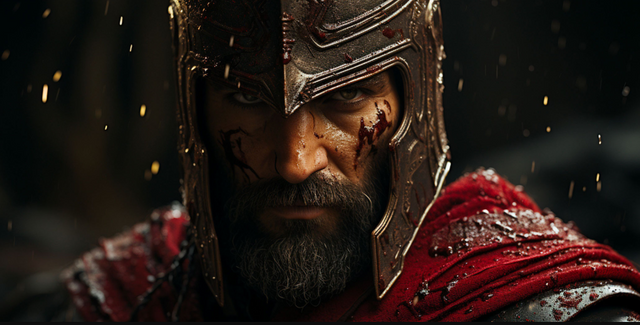Leonidas and his legendary 300 Spartans

Leónidas, rey espartano que junto a sus 300 guerreros derramó su sangre y dio su vida por Esparta, padre, esposo. Guerrero orgulloso, buen rey pero sobre todo un héroe cuyo coraje, honor y determinación han trascendido el tiempo y la historia. Pero es cierto que el rey Leónidas y sólo 300 hombres lograron defender durante días el paso de las Termópilas contra un ejército que lo superaba en número en decenas de miles de hombres. ¿Cuánto hay de mito y cuánto de realidad en esta historia? Prepárate porque hoy conocerás la verdad sobre Leónidas y sus 300 hombres.
Sparta: The Cradle of the Lion
The story of Leonidas dates back to the year 540 BC in the region known as Lacedaemon or La Conia and whose most important city was Sparta, Leonidas was born as the third son of King Agada Anaxandridas, so his destiny at least in principle was not to become king, that responsibility was destined to his half-brother Cleomenes, his father's firstborn, or in the absence of this, to Dorie, his second eldest brother; one might think that coming from a royal lineage, Leonidas had the privileges and facilities necessary to become the most famous warrior king in history, however, Leonidas, whose name means son of the lion.
Like any other Spartan he had to face a long list of trials and challenges, but let's go step by step: in ancient Greece every polis or city-state shared a similar culture, although each had its own customs and those of Sparta were not similar to those of any other city. The city was ruled not by one but by two kings, what is known as a diarchy and each king or diarch shared religious and military responsibilities. However, the power of its kings was limited by the gerusa, a council of elders in charge of approving laws and making important decisions, and also by five ephors or magistrates, while in the rest of the Greek city-states numerous offices were exercised.
such as crafts, music, construction or politics in old Sparta the permanent center of society was war and military life.
A Spartan had to earn his birth with sweat and blood.
The child was carefully examined by the council of elders who would determine if the child was strong and healthy enough to become a fierce warrior or, failing that, a strong woman capable of producing more warriors. Some historians claim that children who failed the test were left alone in a Ravine at the foot of Mount Taygetos to die. Once the children were examined and passed the test, they faced a long and arduous journey before becoming warriors. unsurpassed and full-fledged citizens Just.
Arrival of the Achaemenid Persian Empire
At that time the greatest power in the ancient world was the Achaemenid Persian Empire It is said that the Achaemenid army exceeded one million men and reached an area of 3 million square kilometers, regions far from the ancient world Like India, Egypt or Babylon in the year 490 BC, the then ruler of the Achaemenid Empire Darius I attempted for the first time to annex the Greek peoples. His attempts, however, fell on deaf ears after the Persian forces were defeated on the coast of Marathon. That defeat was a deep wound to the pride of power of the Persian Empire. And 10 years later, after the death of Darius, it was his son, King Xerxes I, who set out to avenge that defeat and surpass his father's legacy.
Xerxes assembled the largest army of the time, the number of men that made up this force is highly disputed and although the Greek historian Herodotus claimed that Xerxes' forces exceeded 2 million soldiers, most sources In modern times it is thought that there were around 250,000 men, whatever the enemy, powerful enough to wipe out all the Greek city-states and for the first time in many years they put aside their internal quarrels and united in a confederation of polis and what did they call themselves? They were called the Hellenic League, a league that brought together not all but some of the most powerful polis of Greece For example Corinth Thebes Athens and of course Sparta, but the Spartan people had a problem, that is, they were as much martial as they were religious and faced with imminent danger.
With all this history, Zack Snyder made a film that was a huge success at the box office, grossing more than $450 million worldwide. However, it received mixed reviews. While some praised its spectacular action and visual style, others criticized it for its lack of historical accuracy and overly stylized tone. There has also been debate over the portrayal of the Persians and the underlying message of the film.
The sequel 300: Rise of an Empire was released in 2014, expanding the story, focusing on the Battle of Artemisium and the Greek revenge that followed the events of the first film. But in the story, this battle took place when Leonidas was at Thermopylae, cutting off the land passage and the Artemisium by sea.



This film was / is so legendary. The filming techniques and action sequences were the first of their kind as far as I know, and the story is really compelling as is the narration and acting.
I have seen this film many times and gladly watch it again when I get the chance. I can't say that about very many films ever made.
The same thing happened to this movie when The Matrix was released.
funny thing about the Matrix... I saw it in theaters when it was released and didn't like it. It took me a few years but I came around and now really like it as well. I still remember writing on our shared whiteboard in our two-bedroom apartment that the Matrix was "the worst movie since Cabin Boy."
I learned later to regret the decision to write those words.